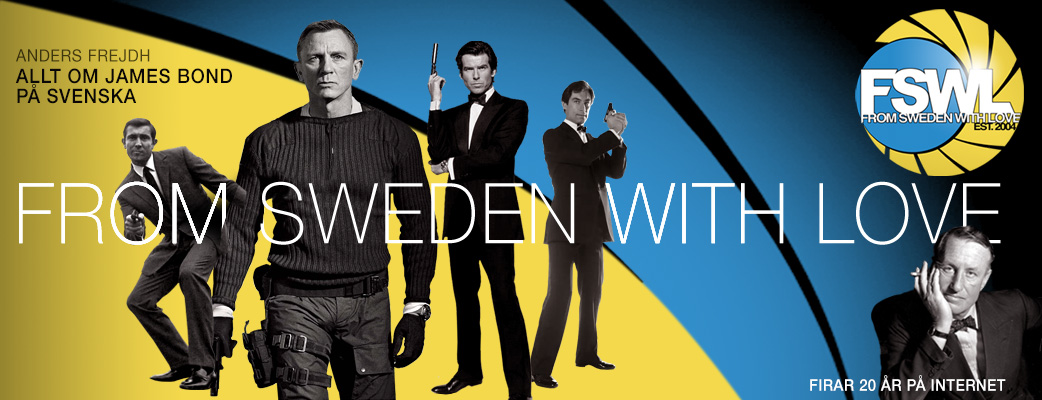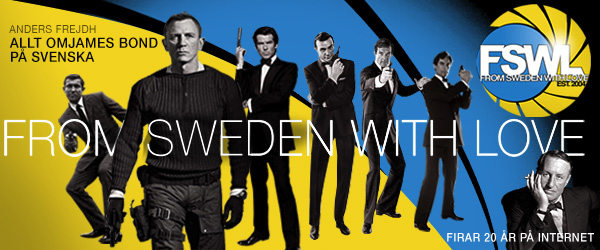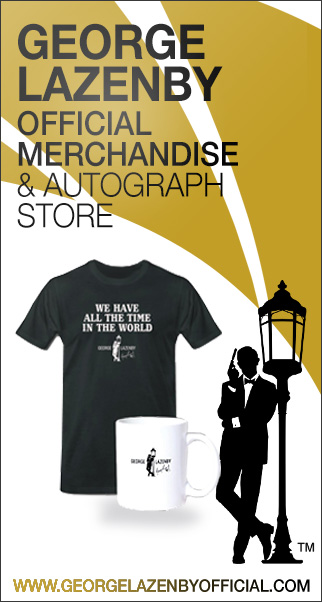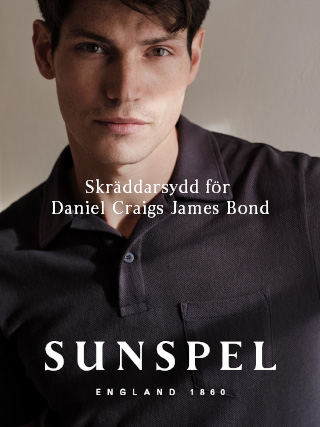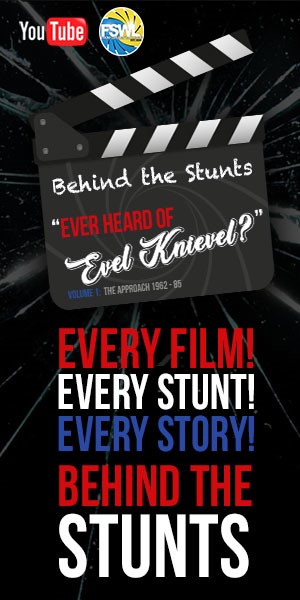Hemsidan senast uppdaterad: 2024-03-21
Hem
Bok- och filmrecensioner
Event
FSWL Merchandise
Intervjuer
James Bond 007 filmerna
James Bond 007 litteratur
James Bond 007 nyheter
James Bond 007 produkter
James Bond 007 samling
James Bond 007 shop
James Bond 007 spel
James Bond fanklubbar
James Bond personligheter
Svenskar i Bond-filmerna
TûÊvlingar
Till minne av
James Bond fûÑrelûÊsning med Oscarsvinnaren Norman Wanstall
Av: Anders Frejdh
Publicerad:
2006-04-30
2006-04-30
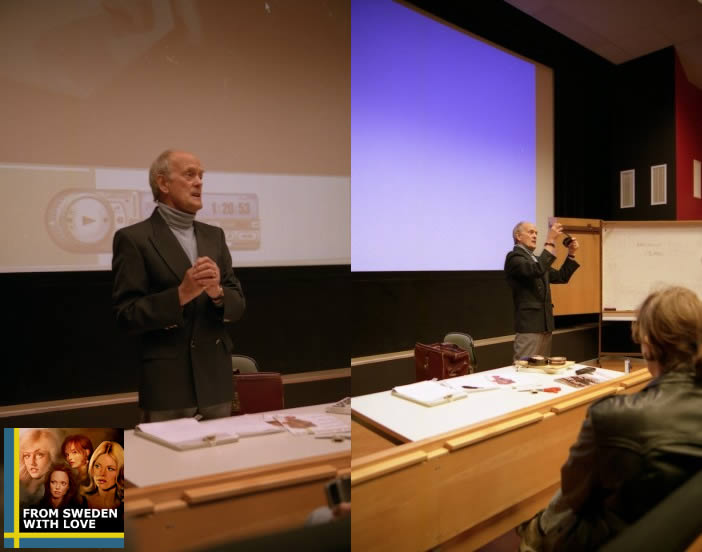
Two courses were prepared and the responsibility was in the hand of one of the universities foremost lecturers, Ulf Wilhelmsson. The courses themselves gave students 7.5 credit points respectively, according to European university principles.
Among areas examined during the A course was:
ã Genus theory and the structuralism of an action film
ã Methods for film analysis
ã The historical background and influence for action films
ã Adaptation of novel into film
ã Actors and actresses, characters and genus
Among areas examined during the B course was:
ã Structure and functionality of dialogue
ã Song lyrics and the use of music
ã The possibilities and restraints of time, room and environment
ã The films contestations of society
Statistics about the courses:
ã 98 people applied to the basic course in autumn 2005 out of which 56 enrolled
ã 15 people applied to the continuation course in spring 2006 and all enrolled
Literature used in the courses:
ã Film analasys: An introduction written by L G Andersson and E Hedling and published by Studentlitteratur (1999)
ã The 7th edition of Film Art: an introduction written by D Bordwell and K Thompson and published by McGraw Hill (2003)
ã The chapter The Narrative Structure in Fleming written by Umberto Eco from his ãThe Bond Affairã published (1966)
A James Bond lecture with a glance of an Oscar
On 24th April 2006 with an audience of 45 students, the winner of Best Sound Effects for Goldfinger (1964) (1964) at the 37th Academy Awards in 1965 (covering films made mainly in 1964) Norman Wanstall entered the stage inside the movie theatre of the University of SkûÑvde, courtesy of yours truly. He was presented by the person responsible for the course, Mr Ulf Wilhelmsson, to excited and anticipating applause.
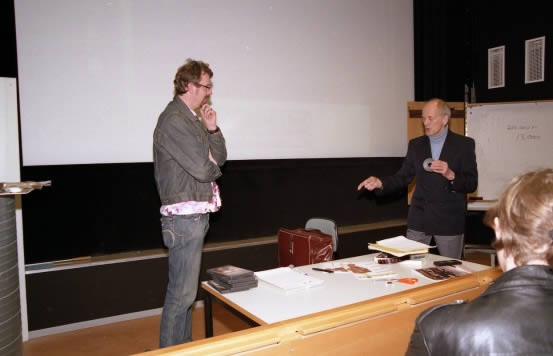
For the benefit of those present who were not familiar with the basic principles of film production, Norman Wanstall began by briefly explaining the procedures carried out during the three main timescales, namely Pre-production, Production and Post-production. He stressed that during the Pre-production stage, (the period prior to the start of shooting), finalising the script and ensuring it was "water-tight" was of the uttermost importance. One could not over-estimate the seriousness of discovering script irregularities once the film was at an advanced stage of shooting. He quoted as an example Never Say Never Again (1983), which he also worked on, and which he said suffered many problems during Post-production caused by serious deficiencies in the script.
Norman then went on to point out that since the days of the early Bond movies major technical changes had taken place in the Post-production stage, with film and soundtracks now edited on computers rather than in rooms full of film cans and a noisy machine called a moviola. Nevertheless he insisted that in spite of the advances in technique the basic principles remain, and on busy action films such as the Bonds the original soundtrack of numerous scenes are set aside and then re-built by replacing all the component parts. The advantage these days is that countless complex sounds can be computer generated or obtained instantly from CDs, whereas for Norman on the early Bonds it was a question of using oneãs own ingenuity, devising means of creating specialised sounds with the use of props, gadgets, library tracks and experts in various fields, and finally mixing the elements together to create the required effect.
It was interesting for the audience to learn that the sound effects editor and the composer usually work independently, so all too often when it comes to the final mixing the music and effects will not play together and one of them has to go. On such occasions the music frequently wins the day, but Norman was proud to tell us that at least in Dr No when Bond escapes down the metal tunnel, the music was discarded in favour of his eerie electronic noise.
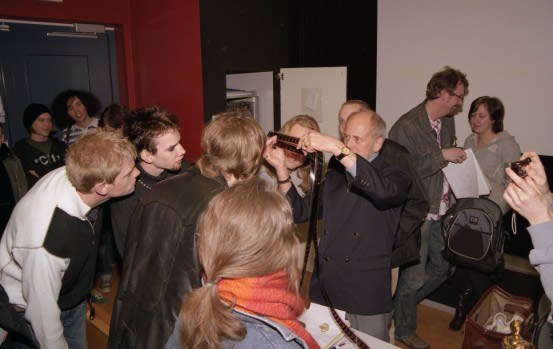
For the rest of the lecture we listened intrigued as Norman took us through each of his Bond films in turn, and explained the challenges he faced and how he created some of the more complex sounds. He explained that the formula for creating a specialised sound is not to attempt to create it in one, but to compile a series of relevant ãingredientsã that can be mixed together in various formats until the best version is achieved. Fortunately for the audience our organiser Ulf Wilhelmsson had done his homework and after each scene was discussed he projected it on the screen using DVDs. This way we could re-live the moments and it was fascinating to see the end result in a new light after everything Norman had explained to us.
ã Dr. No (1962)
Norman was first employed on Dr No as assistant to the editor, Peter Hunt, but he was given his big break as sound-effects editor because the filmãs budget was too small (950,000 USD) to afford hiring an experienced technician. It was an awesome challenge for a first timer, especially as it meant working with the brilliant but highly volatile chief sound mixer at Pinewood, Gordon McCullum. As it turned out McCullum loved the movie and they formed a close team, working together on the specialised sounds early in the Post-production period, with Norman providing the ideas and the ãingredientsã and Gordon blending them together. Unfortunately, owing to the filmãs limited budget, it was a constant battle to convince the accounts department that these expensive mixing sessions were justified.
Strange as it may seem now, the first sound Norman created was the silenced pistol. He had searched far and wide for a recording of the genuine article but without success, so he had no choice but to make his own.
Many of the biggest challenges of course occurred inside Crab Key, the lair of villain ãDr Noã (played by Canadian actor Joseph Wiseman), with James Bond (played by Sean Connery) and ãHoney Ryderã played by the gorgeous Swiss actress Ursula Andress). Norman explained how he combined numerous tracks to create an original sound for the electronic elevator, plus the sound of the metal idol being crushed in Dr Noãs hooked hands. Also he had major problems creating the distant threatening rumble of water in the escape tunnel prior to it cascading over Bond.
He assured us though that no sound in any of his future Bonds was as difficult to create as the atomic reactor in Dr Noãs laboratory, varying in pitch and intensity as its hand-wheel was turned on the gantry. It seemed at the time to be an impossible task, as no facilities existed to create a threatening sound that could be synchronised to the movements of the wheel. In desperation Norman turned to the electronic maintenance engineer at Pinewood for help, who, after weeks of experimentation produced the crudest and most extraordinary-looking machine anyone had ever seen, but which, to Normanãs relief when a switch was thrown, fulfilled the requirements to perfection.
ã From Russia with Love (1963)
Norman had no hesitation in admitting that of the five Bonds heãd worked on this was his favourite, and considering the amount of sound-effects required for trains and boats and planes it was probably the most demanding. Fortunately, after the success of Dr No the budget doubled (2,000,000 USD), so when he approached the production office with expensive requests they were more eager to please than they had been previously. Re-recording the helicopter chase was a particularly expensive session, and when he requested a large mixed crowd of Turks and Russians for the gypsy camp scene they were supplied without question. The end result certainly met with the approval of director Terence Young who congratulated Norman on the authentic atmosphere the voices created.
Norman also described how the brilliant sound recordist John Mitchell was allowed to disguise himself as one of the baddies in the speed boat chase, so that he could secretly make recordings of the boatsã engines as the scene was being shot.
The amazing fist-fight scene in the train between Bond and ãRed Grantã (played by the late English actor Robert Shaw) was projected on the screen for us by Ulf, and Norman explained how heãd re-recorded all the violent body moves for dramatic effect, and how pleased he was that instead of music the scene was played out against the thundering rattle of his speeding train.
Sadly before the end of shooting he was called to London to supervise the re-recording of certain dialogue lines spoken by Pedro Armendariz, the actor who played ãAli Kerim Bey ãin the film. It emerged that Pedro was in fact a very sick man, and the filmãs makers were forced to shoot his scenes in high priority order. Within days of his departure from the UK the crew was informed of his tragic death.
ã Goldfinger (1964)
This film, considered by many to be the best in the series, was directed by Englishman Guy Hamilton who later went on to direct another three Bond films; Diamonds Are Forever (1971), Live and Let Die (1973) and The Man with the Golden Gun (1974). Not only was it awarded an Academy Award as one of only two Bond films to receive that honour (the other being Thunderball for which the late John Stears won for Best Special Effects), it also became the most successful in relation to the number of multiples it took in gross income at the box office compared to its budget (2,500,000 USD).
When discussing his work on this film Mr Wanstall particularly mentioned two sounds he created that relate to the character of ãOddjobã (played by the late Japanese wrestler Harold Sakata). Firstly he explained how various tracks were mixed to create the sound of the golf ball being crushed in Oddjobãs hand, but in particular he referred to the sound of the flying metal hat used by Oddjob as a lethal weapon. It was fascinating to hear how that memorable ã flying ãsound was created using simple kidsã toys as props, whilst a carpenterãs wood saw was finally selected to create the menace of the hat leaving Oddjobãs hand.
Probably one of the most well remembered scenes in Goldfinger is the car being crushed in the breakerãs yard, and Norman told the remarkable story of how he finally obtained the most crucial sound that the scene demanded. After much research he had totally failed to find an existing track to cover the mighty jaws of the crusher as it heaved upwards and downwards against the carãs body. The sound recorded at the time was simply an overall noise of the entire machine, whereas it was essential to have a dramatic individual track to cover the close shots of the jaws.
Just as he was running out of ideas some workmen arrived on the studio lot and set up a compressor within earshot of his editing room. Suddenly realising that this was the exact sound he was looking for Norman rushed to find his sound recordist, only to be told that he couldnãt leave the set as they were in the process of shooting a scene. The only spare piece of equipment the recordist had available was a cheap kiddiesã recorder that heãd bought for a few pounds the day before as a present. Dreading that the compressor would be removed at any moment, Norman dashed across the studio lot with the kidsã toy and recorded the priceless sound on a microphone smaller than a cigarette lighter. To this day the scene remains one of the highlights of the early Bonds and in many peopleãs estimation was a major factor in the award nomination.
It is without doubt a remarkable story, and a startling view behind the scenes of the high-tech world of the movies!!
ã Thunderball (1965)
The repeated success of Bond No 3 really triggered the long-lasting ingredients for the phenomenon that Albert R. Broccoli and Harry Saltzman had now created. Not only did they manage to more than triple (9,000,000 USD) the budget for Goldfinger, but they were also inspired to create the biggest Bond film of all with Englishman Terence Young directing for the third time.
Mr Wanstall explained that he recognised immediately the biggest challenge for him would be the underwater scenes, so he experimented at an early stage with various basey water sounds which composer John Barry listened to with great interest. Barry said he would compose in a higher register to complement the basey water atmospheres, but whether this was a success in the final analysis is open to question. As an example of a highly dramatic sound that he had faked in the recording studio, Norman nominated the Vulcan bomber crash-landing on the surface of the ocean.
ã You Only Live Twice (1967)
Directed by Englishman Lewis Gilbert, who later directed The Spy Who Loved Me (1977) and Moonraker (1979), this film, was mainly shot on location in Japan, and at various sound studios inside Pinewood Studios in England.
The budget was again on a high level (9,500,000 USD), and Mr Wanstall enjoyed telling us how the success of the previous films enabled him to make outrageous requests of the production office, compared with the financial restraints that heãd constantly encountered on Dr No. He gave as an example the scene involving a small aircraft in which Bond (for the fifth time played by Sean Connery) is trapped and abandoned by ãHelga Brandtã (played by German actress Karin Dor.) The exterior shot of the plane dropping to earth out of control was shot without sound, so with tongue firmly in cheek Norman asked the production office for a pilot who could take a plane up to a great height and drop it out of the sky. To this day he remembers his amazement when the reply came back......."OK, when do you want it?"
It was fortunate for Norman that after the completion of Thunderball he worked as Peter Huntãs sound editor on IPCRESS FILE, and after much research he found a brilliant technician working at the BBC Radio phonic Workshop who was able to create the amazingly complex Ipcress Sound. Faced with the problem of creating effects for the mighty volcano rocket in You Only Live Twice Norman called upon the man again, and to the surprise and admiration of all concerned the rocket sound was born. It suggests that the technicians of the Radio phonic Workshop were early pioneers in the exciting new era of electronically generated sound effects.
About Norman Wanstall
Wanstall learned his trade assisting the legendary Sound Editor, Winston Ryder.
Itãs worth pointing out that Mr Wanstall began his career in the fifties when most of the film industry was based in permanent film studios. Technicians were employed on three-year contracts and one just worked on one film after another. In other words, film studios were basically factories which turned out films as a product. When a technicianãs contract expired he or she was called into the office and a new contract was negotiated. It was a good system in many ways because everyone was given a thorough training in their particular department and those who showed they had talent were slowly promoted up the ladder. There were a number of freelance technicians in the industry not attached to any particular studio, some of whom were top people like Winston Ryder who worked on major American productions and were relatively highly paid.
Wanstall started as a trainee film editor at Pinewood Studios (J. Arthur Rank) on a three-year contract, and during his time there he was promoted to assistant sound editor on CARVE HER NAME WITH PRIDE and NIGHT TO REMEMBER. As his contract was coming to and end he was told that the great Winston Ryder was looking for an assistant and everyone seemed to think he was the right man for the job. Eager to gain experience on major productions he turned down the chance of a new contract and went freelance with Ryder. Ryder was a very difficult man to work with but he was probably the greatest sound editor of his day, with such films as LAWRENCE OF ARABIA and THE BRIDGE ON THE RIVER KWAI to his credit. Norman assisted him on JOHN PAUL JONES, SOLOMON AND SHEBA and SINK THE BISMARK which was edited by the rising star, Peter Hunt.
Hoping for a spell as an assistant Film Editor as opposed to assistant Sound Editor Norman approached Hunt and consequently assisted him on THERE WAS A CROOKED MAN, THE GREENGAGE SUMMER and HMS DEFIANT (THE MUTINEERS). Then came DR NO and the rest is history.
Credits for Sound (Dubbing) Editor:
ã DOCTOR NO
ã CALL ME BWANA
ã FROM RUSSIA WITH LOVE
ã GOLDFINGER
ã THUNDERBALL
ã IPCRESS FILE
ã FAHRENHEIT 451
ã YOU ONLY LIVE TWICE
ã BARRY LYNDON (Asked not to have credit)
ã NEVER SAY NEVER AGAIN
Credits for Picture Editing:
ã JOANNA
ã TWINKY
ã THE ONLY WAY
ã JERUSALEM FILE
ã NEITHER THE SEA NOR THE SAND
ã WHO?
ã ECLIPSE
Note:
Normanãs daughter, Tania, continued in her fatherãs footsteps by working as a sculptor, modeller, make-up artist and hair stylist on famous and successful box-office films such as SAVING PRIVATE RYAN (1998), HARRY POTTER & the SORCERERãS STONE (2001) and TROY (2004).
After the first year with these courses lined up in University of SkûÑvdeãs programme the responsible person behind them, Mr Wilhelmsson was most pleased with was that the initial idea of analysing the films from various angles worked so well. He think the Bond series itself persists a good and valuable database of information in order to understand film theory overall. Another thing he found interesting was that despite the films in the beginning seems similar they are in fact very different as each one of them reflects the society during the time each were made.
Our sincere thanks to Norman Wanstall for sharing his memories with FSWL.
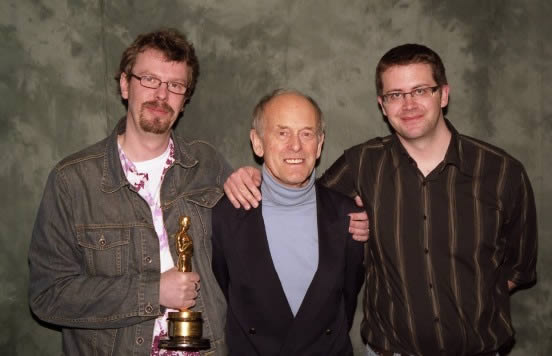
Ulf Wilhelmsson with Norman Wanstall and Anders Frejdh. Copyright ôˋ 2006 From Sweden With Love
Taggar:
#anders_frejdh
#artiklar
#intervjuer
#norman_wanstall
Tweet
